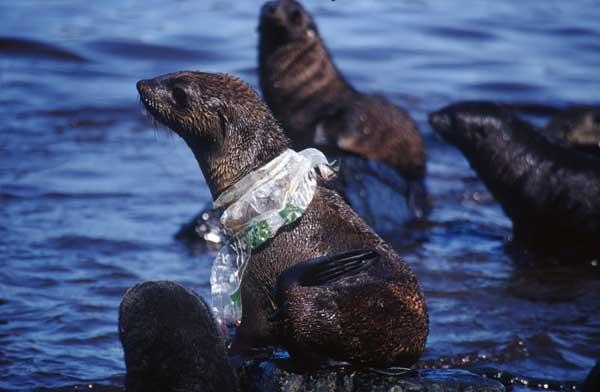
Pieces of Plastic Found Floating in Pristine Antarctic

Boat expeditions to the seas around Antarctica in 2008 found pieces of plastic floating around in the remote waters, raising worries about the impact this plastic pollution could have on the ecosystems of these relatively pristine environments if it were to continue accumulating.
Both the Pacific and Atlantic Oceans have large areas of open water that are covered with floating bits of plastic this area of the Pacific is called the "Great Pacific Garbage Patch."
The plastic that ends up in these floating dumps comes from many sources ships at sea, polluted coastal towns and land-based garbage dumps. The plastic pieces are hemmed in by circular ocean currents and mostly float near the surface of the water.
Plastic floating in the ocean is a worry because it can be degraded by the actions of water and ultraviolet radiation and wind up as microscopic fragments that can be ingested by fish and other marine organisms and contaminate the food chain. Larger pieces can also endanger animals that can get caught in plastic bags and strips.
In the past, scientists had spotted the occasional piece of plastic in the waters around Antarctica, collectively known as the Southern Ocean , but no widespread survey looking for plastic pollution had been done in those waters the most remote and least visited seas on the planet.
"It's a long way from anywhere," said David Barnes of the British Antarctic Survey, a member of one of the expeditions.
Surveying the Southern Ocean
Sign up for the Live Science daily newsletter now
Get the world’s most fascinating discoveries delivered straight to your inbox.
In the austral summer of 2007-2008, Greenpeace and British Antarctic Survey (BAS) ships conducted the first coordinated and widest survey for plastics ever undertaken around Antarctica. The survey in particular looked at the Amundsen Sea, where biologists have never before visited and taken samples. Their findings provided some good news, and some bad.
The survey found that large pieces of plastic were not abundant in the seas studied the Amundsen Sea along with the Scotia, Bellingshausen, Durmot D'Urville, Davis and Cosmonaut seas but that plastic detritus was reaching even areas with virtually no local human presence.
"To find plastic floating in the sea was quite depressing," said Barnes, who was at least heartened by the fact that the surveys found no plastic debris in samples from the sea floor.
The surveys' findings are detailed in the August 2010 issue of the journal Marine Environmental Research.
Possible hitchhikers
While the amount of plastic present in the oceans around Antarctica is "much less" than in the Pacific or Atlantic, the effect that might have "could be disproportionately high," Barnes told OurAmazingPlanet.
The worry is that those bits of plastic floating into the Antarctic from elsewhere around the globe could harbor microbes or other life that isn't native to the southernmost continent and its environs. These hitchhikers could establish themselves on the continent or the islands around it and potentially become invasive species , pushing out natives.
The plastic in the oceans has introduced "a whole new habitat and a whole new possibility of animals getting around," Barnes said.
And while Antarctica is bounded by currents that would seem to act as a means of keeping plastic from penetrating into the Southern Ocean, the natural barrier isn't fool-proof, and plastic will likely gradually build up in Antarctic waters.
"I expect one day it will. I see no reason why not," Barnes said. "It's impossible to completely prevent this sort of thing."
Though the accumulation of plastic in Antarctica will always lag behind that of the other oceans, both because it is less traveled and because those who do venture there tend to be aware of the potential of contaminating one of Earth's last pristine areas.

Andrea Thompson is an associate editor at Scientific American, where she covers sustainability, energy and the environment. Prior to that, she was a senior writer covering climate science at Climate Central and a reporter and editor at Live Science, where she primarily covered Earth science and the environment. She holds a graduate degree in science health and environmental reporting from New York University, as well as a bachelor of science and and masters of science in atmospheric chemistry from the Georgia Institute of Technology.









